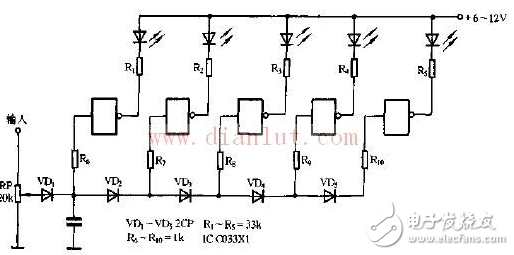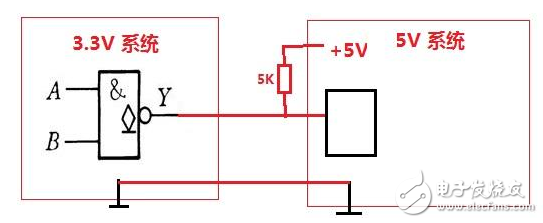The COMS integrated circuit is an abbreviation of Compiementary symmetry metal oxide semi-conductor integrated circuit. Many basic logic units of the circuit are connected in a complementary symmetrical form by an enhanced PMOS transistor and an enhanced NMOS transistor. Very small consumption.
The supply voltage VDD range of the COMS circuit is relatively wide at +5~+15V, and the voltage fluctuation is allowed to ±10. When the output voltage is higher than VDD-0.5V, it is logic 1, and the output voltage is lower than VSS+0.5V (VSS). For digital ground) is logic 0. The CMOS circuit outputs a high level of approximately 0.9Vcc, while the output low level is approximately 0.1Vcc. When the input voltage is higher than VDD-1.5V, it is logic 1 and the input voltage is lower than VSS+1.5V (VSS is digital ground). Logic 0.
TTL level signals are utilized most because the usual data representation is binary, +5V is equivalent to logic "1", 0V is equivalent to logic "0", which is called TTL (transistor-transistor logic level) signal System, which is the standard technique for communication between various parts of a device controlled by a computer processor.
Standard TTL input high level minimum 2V, output high level minimum 2.4V, typical value 3.4V, input low level maximum 0.8V, output low level maximum 0.4V, typical value 0.2V (input H > 2V, input L "0.8V; output H" 2.4V (3.4V), output L "0.4V (0.2V).
Is the CMOS level digital or analog?The CMOS level is a digital signal. The supply voltage VDD range of the COMS circuit is relatively wide at +5--+15V, and the voltage fluctuation allows ±10. When the output voltage is higher than VDD-0.5V, it is logic 1. Output voltage Below VSS+0.5V (VSS is digital ground) is logic 0, and the general digital signal is 0 and 1.

1. Logic levels of TTL circuits and CMOS circuits
VOH: Output voltage of logic level 1
VOL: Output voltage of logic level 0
VIH : Input voltage of logic level 1
VIH : Input voltage of logic level 0
TTL circuit threshold:
VOHmin = 2.4V VOLmax = 0.4V VIHmin = 2.0V VILmax = 0.8V
CMOS circuit threshold (power supply voltage is +5V)
VOHmin = 4.99V VOLmax = 0.01V VIHmin = 3.5V VILmax = 1.5V
2, TTL and CMOS logic level conversion
CMOS level can drive TTL level
The TTL level does not drive the CMOS level and requires a pull-up resistor.
3, using logic chip features
74LS Series: TTL Input: TTL; Output: TTL
74HC Series: CMOS Input: CMOS; Output: CMOS
74HCT Series: CMOS Input: TTL; Output: CMOS
CD4000 Series: CMOS Input: CMOS Output: CMOS.

(1) Transistor + pull-up resistor method
It is a bipolar transistor or MOSFET. The C/D is connected to a positive pull-up resistor. The input level is very flexible and the output level is roughly the positive power level.
(2) OC/OD device + pull-up resistor method
Similar to (1). Applicable when the device output is just OC/OD.
(3) 74xHCT series chip boost (3.3V→5V)
Any 5V CMOS device with input 5V TTL level compatibility can be used as a 3.3V → 5V level shifter.
- This is because the level of 3.3V CMOS is just compatible with the 5V TTL level (coincidence), and the output level of CMOS is always close to the power level.
Cheap options such as the 74xHCT (HCT/AHCT/VHCT/AHCT1G/VHCT1G/...) series (that letter T means TTL compatible).
(4) Over-limit input step-down method (5V → 3.3V, 3.3V → 1.8V, ...)
Any logic device that allows input levels to exceed the power supply can be used to reduce the level.
The "overrun" here refers to exceeding the power supply, and many older devices do not allow the input voltage to exceed the power supply, but more and more new devices have eliminated this limitation (changing the input stage protection circuit).
For example, in the 74AHC/VHC series chips, the datasheets clearly indicate that the input voltage range is 0~5.5V. If the 3.3V power supply is used, 5V→3.3V level conversion can be realized.
(5) Dedicated level conversion chip
The most famous is the 164245, which can be used not only as a boost/buck but also to prevent the two sides from being out of sync. This is the most common level shifting solution, but it is also very expensive (not long ago, it was ¥45/piece, although it was retail and expensive), so if it is not necessary, it is best to use the first two options.
(6) Resistance division method
The easiest way to lower the level. The 5V level is divided by 1.6k+3.3k resistor, which is 3.3V.
(7) Current limiting resistor method
If there are too many resistors on the top, sometimes only one current limiting resistor can be connected in series. Although some chips do not allow the input level to exceed the power supply in principle, it is still safe to connect a current limiting resistor in series to ensure that the input protection current does not exceed the limit (eg, 20 mA for the 74HC series).
The ultra-thin precision cutting of the Anti-Peep Screen Protector means that you can enjoy a perfect touch screen experience without allowing anything on the screen to be peeped. Whether you place your phone horizontally or vertically, Privacy Screen Protector can protect your personal Information and sensitive information are protected from harm by strangers. People around you cannot see the contents of your phone, so your details are safe.
The use of soft TPU material can really cover the entire screen.
With self-healing function, it can automatically repair bubbles and scratches within 24 hours.
The 0.14mm Ultra-Thin Protective Film can maintain the sensitivity of the touch screen to accurately respond to your touch.
The oleophobic and waterproof coating prevents fingerprints, oil stains and other substances from adhering to it and keeps the screen clean.
If you want to know more about Privacy Screen Protector products, please click Product Details to view the parameters, models, pictures, prices and other information about Privacy Screen Protector products.
Whether you are a group or an individual, we will try our best to provide you with accurate and comprehensive information about Privacy Screen Protector!
Anti-Spy Hydrogel Screen Protector, Privacy Protection Film, Protection Film, Privacy Film, Privacy Screen Protective Film, Soft Film
Shenzhen Jianjiantong Technology Co., Ltd. , https://www.jonsun-sz.com